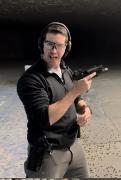doing a split off of the competition thread discussion of safety.
So is it a detriment to get on the trigger later then sooner?
My opinion is no, since I have managed more threats then I have shot. I stated earlier that I did a lot of searching/detaining of people and one of the biggest things I stressed was safety and full extension of trigger finger.. Why? Enough can change in a situation from when you take a weapon off safe/put your finger in the trigger for a GOOD shoot to become a BAD shoot. I know some will say that will potentially get you or someone else killed, I would argue that it is a compromise of averages. I gave more people the front site post then I ever engaged so it seemed better to give myself a barrier between don't shoot/shoot. It only takes one stupid decision to ruin your life. I am trying to find the video of the officer who is covering a suspect being cuffed when she NDs her Glock into him, pretty good example of what I am talking about.
*Mods, if this is in the wrong area I apologize.
edit:It looks like a Beretta?



 Reply With Quote
Reply With Quote





